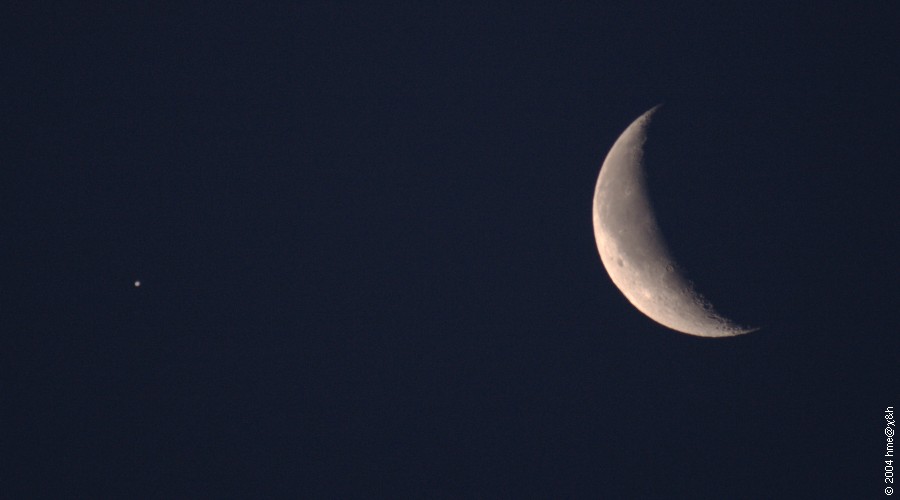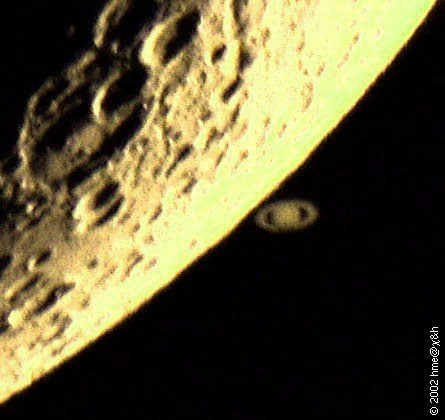
{ Practical astronomy | Astronomy | The Moon | Conjunctions }
Conjunctions
Conjunctions and occultations
The Moon on its monthly round of the sky passes all the planets. Most of these encounters are no closer than a few degrees, but sometimes the encounter is more dramatic. In the image, while for Europe the Moon passes below the planet (some hours after this image during the day), the United States observe an occultation, with the Moon passing in front of the planet.
Physical parameters:
- Distance: 378,000 km, 876,000,000 km
- Equatorial radius: 1,740 km, 71,500 km
- Mass: 1/81 MEarth, 320 MEarth
- Surface gravity: 1/6 gEarth, 2.5 gEarth
The imaging strategy is dictated by how close the planet and Moon get. The field of view has to match this. The image here is essentially similar to the atlas of lunar phases.
Image parameters:
- Camera: Canon EOS 300D
- Detector: 22 × 15 mm
- Focal length: 800 mm
- Field of view: 1.7 × 1.1°
- Aperture: f/12.6
- ISO: 400
- Exposure: 5 ms
- Location: Edinburgh
Lunar occultations
In this image, Europe was lucky and the Moon occulted the ring planet Saturn. The image shows the planet just after it emerges from behind the Moon.
Physical parameters:
- Distance: 391,000 km, 1,456,000,000 km
- Equatorial radius: 1,740 km, 60,300 km
- Mass: 1/81 MEarth, 95 MEarth
- Surface gravity: 1/6 gEarth, 1.1 gEarth
The imaging strategy is dictated by how close the planet and Moon get. The field of view has to match this. This image is equivalent to imaging the planet or lunar detail, and so a webcam was used. Luckily, the Moon was only a crescent and not too bright compared to Saturn. An occultation of a planet is a very photogenic and dynamic event. You should consider taking a time-lapse or real-time movie.
Image parameters:
- Camera: Philips ToUcam Pro
- Detector: 3.6 × 2.7 mm
- Focal length: 2000 mm
- Field of view: 6 × 4'
- Aperture: 200 mm
- Exposure: 4 ms
- Location: Earlyburn
Lunar eclipses

Lunar eclipse 2007-03-03, penumbra. |

Lunar eclipse 2007-03-03, partial phase. |

Lunar eclipse 2007-03-03, partial phase. | |

Lunar eclipse 2007-03-03, total phase. | |
A lunar eclipse occurs when the Full Moon moves through the shadow of the Earth. In the first image, two thirds of the Moon have moved into the penumbra – a zone of semi-shadow where the amount of sunlight is reduced only slightly. In the second image, the Moon has moved deeper into the shadow and 30% of it is now in the umbra – the dark core where in theory no sunlight reaches. Indeed, the umbra appears to be completely dark at this short exposure.
In the third image, the Moon is 70% inside the umbra. This longer exposure reveals that some – mostly red – light does enter the umbra. This is because the Earth's atmosphere acts as a lens and refracts some sunlight into its shadow. Also note the two stars: On the left is 59 Leonis (5.0 mag), on the right 56 Leonis (5.8 mag). Use the stars as reference points, and the final image shows how the Moon has moved by more than its radius and is now entirely deep into the umbra. The image is overall fainter, because no direct sunlight hits the Moon, which would in turn spoil our sky background as it does in the third image. Still, the umbra is not evenly dark, the top of the Moon is brighter, because it is less deep into the umbra than the rest of it.
Unlike moonscapes, photographing a lunar eclipse really requires to have the whole moon in the field of view. Deep into the eclipse, other objects nearby may be interesting to capture as well. A field of view of 2° or more seems advisable. At the same time, the Moon itself should be recorded with at least, say, 500 pixel diameter.
Observe that the umbral exposures here are 1000 times longer than exposures of the penumbral Moon, which is almost at Full Moon brightness. If you go for longer focal length, even longer exposures are needed. Tracking (at lunar rate) is necessary.
Image parameters:
- Camera: Canon EOS 300D
- Detector: 22 × 15 mm
- Focal length: 400 mm
- Field of view: 2 × 2°
- Aperture: f/6.3
- ISO: 100
- Exposure: 5 ms (penumbra), 5 s (umbra)
- Processing: Unsharp mask, no contrast or brightness enhancement.


